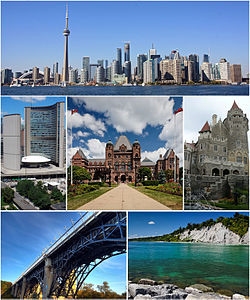[vc_row top_padding=”10″][vc_column width=”1/1″][vc_column_text]
*Toronto, Canada
 Toronto (/tɵˈrɒntoʊ/, local /təˈrɒnoʊ/ or /ˈtrɒn–/) is the most populous city in Canada, and the capital of the province of Ontario. In 2011, Toronto had a population of 2,615,060, making it the fourth most populous city in North America, after Mexico City, New York City, and Los Angeles. TheGreater Toronto Area (GTA) is the most populous metropolitan area in Canada with 5,583,064 people living in the census metropolitan area as of 2011. Classified as an alpha global city by the Globalization and World Cities Research Network, Toronto is a leading international centre of business, finance, arts, and culture.
Toronto (/tɵˈrɒntoʊ/, local /təˈrɒnoʊ/ or /ˈtrɒn–/) is the most populous city in Canada, and the capital of the province of Ontario. In 2011, Toronto had a population of 2,615,060, making it the fourth most populous city in North America, after Mexico City, New York City, and Los Angeles. TheGreater Toronto Area (GTA) is the most populous metropolitan area in Canada with 5,583,064 people living in the census metropolitan area as of 2011. Classified as an alpha global city by the Globalization and World Cities Research Network, Toronto is a leading international centre of business, finance, arts, and culture.
The area now called Toronto has been inhabited for thousands of years by various Aboriginal peoples. The urban history of the city dates back to 1787, when British officials negotiated the Toronto Purchase with the Mississaugas of the New Credit. They established the Town of York, and later designated it as the capital of Upper Canada. During the War of 1812, York was ransacked and heavily damaged by U.S. troops in the Battle of York. The town was renamed and incorporated as the City of Toronto in 1834, and became the capital of the province of Ontario in 1867. Toronto has occasionally expanded through amalgamation with surrounding municipalities throughout its history, the results of which can be seen in the 140 independently unique and clearly defined official neighbourhoods that make up the city.
Located in Southern Ontario on the northwestern shore of Lake Ontario, Toronto is situated on a broad sloping plateau intersected by a vast network of rivers, deep ravines, and urban forest. It anchors the Golden Horseshoe, a densely populated region surrounding the western end of Lake Ontario that is home to 8,686,923 people, or around 26% of the entire population of Canada. The cosmopolitan and multicultural demographics of Toronto reflect its current and historical role as an important destination for immigrants to Canada. It is one of the world’s most diverse cities, with about 50% of residents having been born outside of Canada, and over 200 distinct ethnic origins represented among its population. While English is the primary language spoken by the majority of Torontonians, there are over 160 different languages spoken in the city.
Toronto is a prominent centre for music, theatre, motion picture production, and television production, and is home to the headquarters of Canada’s major national broadcast networks and media outlets. Its varied cultural institutions, which include numerous museums and galleries,festivals and public events, entertainment districts, national historic sites, and sports activities, are key attractions to the over 25 million tourists that visit the city every year. Toronto is well known for its skyscrapers and high-rise buildings, in particular the tallest free-standing structure in theWestern Hemisphere, the CN Tower. As Canada’s commercial capital, the city is home to the Toronto Stock Exchange, the headquarters of Canada’sfive largest banks, and the headquarters of many large Canadian and multinational corporations. Its economy is highly diversified with strengths in technology, design, financial services, life sciences, education, arts, fashion, business services, environmental innovation, food services, and tourism. Toronto is placed among the Global Leaders in the Global Financial Centres Index, and is also consistently rated as one of the world’s most liveable cities by the Economist Intelligence Unit and the Mercer Quality of Living Survey.[/vc_column_text][/vc_column][/vc_row][vc_row top_padding=”10″ bottom_padding=”25″][vc_column width=”1/1″][vc_column_text]
[/vc_column_text][/vc_column][/vc_row][vc_row][vc_column width=”1/1″][vc_column_text]
Travel Tips
Traveling can increase your chances of getting sick. A long flight can increase your risk for deep vein thrombosis. Once you arrive, it takes time to adjust to the water, food, and air in another place. Water in developing countries can contain viruses, bacteria, and parasites that cause stomach upset and diarrhea. Be safe by using only bottled or purified water for drinking, making ice cubes, and brushing your teeth. If you use tap water, boil it or use iodine tablets. Food poisoning can also be a risk. Eat only food that is fully cooked and served hot. Avoid unwashed or unpeeled raw fruits and vegetables.
If you are traveling out of the country, you might also need vaccinations or medicines to prevent specific illnesses. Which ones you need will depend on what part of the world you’re visiting, the time of year, your age, overall health status, and previous immunizations. See your doctor 4 to 6 weeks before your trip. Most vaccines take time to become effective.[/vc_column_text][/vc_column][/vc_row][vc_row top_padding=”10″ bottom_padding=”20″][vc_column width=”1/1″][vc_column_text]*Prices starting at $350, see details.
Source: MedlinePlus[/vc_column_text][/vc_column][/vc_row]












